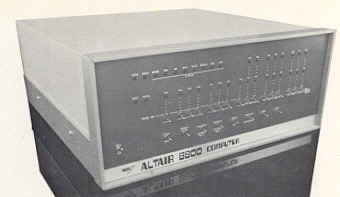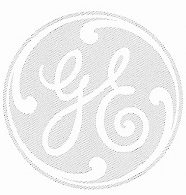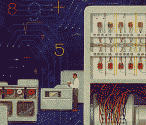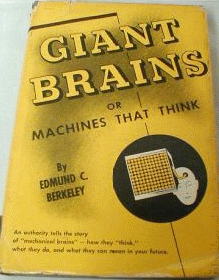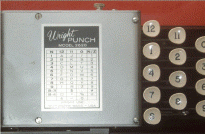I don't have page references for you but these are the volume numbers
with the
quotes in context which should help you find them: James Keeline
TSJR09.txt-1505-
didn't have one of those back in high school."
TSJR09.txt-1506-
He chuckled. "My homework was a trial and
TSJR09.txt-1507-
most of it was in error!"
TSJR09.txt-1508- "Don't feel too bad, pal." Tom grinned.
TSJR09.txt-1509-
"Even electronic brains go haywire, if you don't
TSJR09.txt-1510-
keep them tuned up. They have nervous
TSJR09.txt-1511-
breakdowns in the form of short circuits, and
TSJR09.txt-1512-
give wrong results when you feed them a
TSJR09.txt-1513-
problem."
TSJR09.txt-1514- "In that case," Bud said with a chuckle,
TSJR09.txt:1515:
"I vote we call 'em the Little Idiots!"
TSJR09.txt-1516- "Sure you haven't got a short circuit?"
TSJR09.txt-1517-
Tom retorted with a wide grin.
TSJR09.txt-1518- The young inventor also showed Kent a
TSJR09.txt-1519-
new type of space suit which he had designed
TSJR09.txt-1520-
especially for the satellite expedition. With a
TSJR09.txt-1521-
zippered hood and goggles, it was much lighter
TSJR09.txt-1522-
and more comfortable than the suits used by the
TSJR09.txt-1523-
men who had helped Tom build his Outpost in
TSJR09.txt-1524-
Space.
TSJR09.txt-1525- "Boy!" Bud exclaimed when he tried
--
TSJR12.txt-1120- "What can you do, Tom?" Phyl asked.
TSJR12.txt-1121- "Not a thing, I guess, except keep on
TSJR12.txt-1122-
waiting for the rest of the message."
TSJR12.txt-1123- "But we can't wait," Sandy protested.
TSJR12.txt-1124-
"Not if we want to get back for the party!"
TSJR12.txt-1125- "How much time do we have?" Bud
TSJR12.txt-1126-
asked.
TSJR12.txt-1127- "Well, we're due at seven," Sandy
TSJR12.txt-1128-
replied, "and we have to go home and dress."
TSJR12.txt-1129- Bud grinned. "We'd better work this
TSJR12.txt:1130:
out on one of Tom's Little Idiots."
TSJR12.txt-1131- These amazing miniature computers were
TSJR12.txt-1132-
the smallest and most compact ever built. The
TSJR12.txt-1133-
operator simply "talked" his problem into a
TSJR12.txt-1134-
microphone, and the computer then reeled off
TSJR12.txt-1135-
the answer on tape.
TSJR12.txt-1136- Tom laughingly produced a computer
TSJR12.txt-1137-
and Bud began supplying data to the machine.
TSJR12.txt-1138-
"Now," declared the copilot, "this little gadget
TSJR12.txt-1139-
will tell us what time we'll have to leave here."
TSJR12.txt-1140- Sandy and Phyl giggled at some of his
--
TSJR13.txt-2477-
work on his second matter maker. Besides being
TSJR13.txt-2478-
much more powerful and efficient than his first
TSJR13.txt-2479-
machine, the new model would be able to
TSJR13.txt-2480-
produce many other elements besides oxygen.
TSJR13.txt-2481- "How soon will it be finished?" asked
TSJR13.txt-2482-
Sandy eagerly, as she watched her brother wire
TSJR13.txt-2483-
the electronic control panel.
TSJR13.txt-2484- Before answering, Tom ran off a quick
TSJR13.txt-2485-
series of calculations on one of his amazing
TSJR13.txt-2486-
miniature computers which Bud had dubbed
TSJR13.txt:2487:
"Little Idiots." Then he jotted down a
TSJR13.txt-2488-
correction on his blueprints.
TSJR13.txt-2489- "The design's complete right now, Sis,"
TSJR13.txt-2490-
he replied. "However, the castings and some of
TSJR13.txt-2491-
the larger parts will have to be made back at
TSJR13.txt-2492-
Enterprises. The energy collectors to provide
TSJR13.txt-2493-
power for the machine are being made there,
TSJR13.txt-2494-
too."
TSJR13.txt-2495- "That means we go back to Shopton?"
TSJR13.txt-2496-
put in Bud.
TSJR13.txt-2497- Tom nodded. "The girls and you and I
--
TSJR14.txt-2996-
between the two fields. The brain would use
TSJR14.txt-2997-
only this radiation in making its computations
TSJR14.txt-2998-
and thus produce a clear picture without
TSJR14.txt-2999-
interference.
"
TSJR14.txt-3000- Tom thumped his workbench. "I'm sure
TSJR14.txt-3001-
it will work!" Then he reflected ruefully, "But it
TSJR14.txt-3002-
will take some fancy circuit design to do all that
TSJR14.txt-3003-
without making the camera bigger and clumsier
TSJR14.txt-3004-
than ever!"
TSJR14.txt-3005- Using one of his midget desk computers,
TSJR14.txt:3006:
which Bud had nicknamed "Little Idiot," Tom
TSJR14.txt-3007-
quickly worked out the mathematical angles
TSJR14.txt-3008-
involved and dashed off rough sketches. Then
TSJR14.txt-3009-
he began building two compact transmitters with
TSJR14.txt-3010-
dish-shaped radiating antennas. These would be
TSJR14.txt-3011-
attached at the top and bottom of the camera.
TSJR14.txt-3012- Tom barely paused for supper and kept
TSJR14.txt-3013-
working hour after hour. At midnight Doc
TSJR14.txt-3014-
Simpson walked into the laboratory. "You
TSJR14.txt-3015-
promised to get a good sleep tonight,
TSJR14.txt-3016-
remember?
" the medic reproved sternly.
--
TSJR17.txt-3438-
to San Rosario, including the attack en route by
TSJR17.txt-3439-
unmarked sky raiders. He also privately told his
TSJR17.txt-3440-
father about his plan to use Exman as an
TSJR17.txt-3441-
electronic spy. Mr. Swift was enthusiastic.
TSJR17.txt-3442- The two scientists promptly set to work.
TSJR17.txt-3443-
Mr. Swift built two powerful but miniature radio
TSJR17.txt-3444-
sets; one for receiving, one for transmitting.
TSJR17.txt-3445-
Tom, meanwhile, was busy on another device,
TSJR17.txt-3446-
also highly miniaturized, combining features of
TSJR17.txt-3447-
both the electronic decoder and Tom's famous
TSJR17.txt:3448:
midget computers, known as Little Idiots.
TSJR17.txt-3449- With this equipment, Tom hoped, Exman
TSJR17.txt-3450-
would be able to monitor all communications at
TSJR17.txt-3451-
Brungarian rebel headquarters, then radio the
TSJR17.txt-3452-
information to Enterprises.
TSJR17.txt-3453- Chow brought lunch to the laboratory at
TSJR17.txt-3454-
noon, and Bud came in later. Both stayed to
TSJR17.txt-3455-
watch the outcome of the experiment. Hank
TSJR17.txt-3456-
Sterling and Arv Hanson joined the group.
TSJR17.txt-3457- By midafternoon the equipment was
TSJR17.txt-3458-
ready for a tryout. Tom opened Exman's star
--
TSJR20.txt-1460-
be needed for the experiment. The idea was so
TSJR20.txt-1461-
clear in Tom's head that he plunged into the job
TSJR20.txt-1462-
of constructing the units at once, with only
TSJR20.txt-1463-
rough preliminary sketches or circuit diagrams
TSJR20.txt-1464-
which he had already drawn.
TSJR20.txt-1465- "The radios can be very small and fairly
TSJR20.txt-1466-
low powered," Tom reasoned, "since they'll
TSJR20.txt-1467-
transmit on a very narrow beam of radiation."
TSJR20.txt-1468- Each would need a small computer in its
TSJR20.txt-1469-
base. Tom produced these quickly by converting
TSJR20.txt:1470:
two of his "Little Idiots"--amazing midget
TSJR20.txt-1471-
electronic brains which he had invented for his
TSJR20.txt-1472-
expedition to the phantom satellite.
TSJR20.txt-1473- Several hours went by while Tom
TSJR20.txt-1474-
labored at his workbench. It was soon strewn
TSJR20.txt-1475-
with electronic paraphernalia. As usual, when on
TSJR20.txt-1476-
one of his inventive spurts, Tom worked at
TSJR20.txt-1477-
feverish speed.
TSJR20.txt-1478- The new radios, like his space telescope,
TSJR20.txt-1479-
had extremely sensitive amplifying circuits that
TSJR20.txt-1480-
would have to be supercooled by liquid helium.
 Remember? They used to have offices in Phoenix too!
Remember? They used to have offices in Phoenix too!

